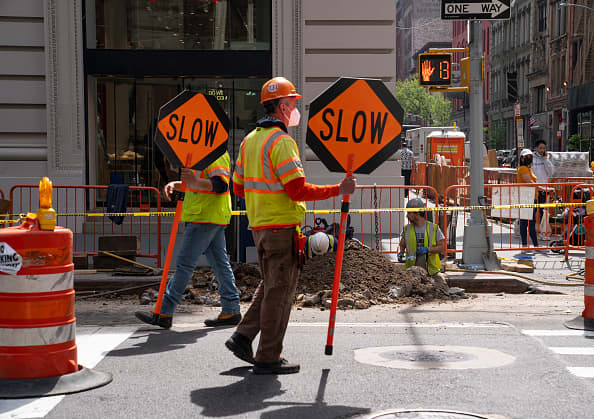These charts show which states will get the most money from Biden’s infrastructure bill

California, Texas and New York will probably money in huge on the trillion-dollar infrastructure bundle if the bill makes its method to President Joe Biden’s desk.
But far-less-populous states – comparable to Montana and Alaska – will get the most money per capita.
The administration believes Californians ought to plan for no less than $44.56 billion in infrastructure funds, the greatest sum for any state, with highways and public transit alone comprising about $34.eight billion of that complete.
Texas is available in at No. 2 with an estimated allocation of $35.44 billion, between $26.9 billion in estimated freeway funds and $3.Three billion in estimated public transit funds. New York, in third, is projected to obtain $26.92 billion.
(adsbygoogle = window.adsbygoogle || []).push({});
See the full list of estimated allocations for each state at the bottom of this article.
CNBC’s evaluation reveals that Vermont, Montana, Wyoming and Alaska lead in relation to estimated per-capita infrastructure spending with ranges no less than $3,500 per resident. California’s estimated per-capita allocation is lower than $1,250 per resident.
The White House, hoping to make good on Biden’s marketing campaign guarantees forward of the 2022 midterm elections, has billed the plan as a generational funding. The Senate overwhelmingly authorized the $1 trillion infrastructure bill earlier this month in an effort to rebuild the nation’s crumbling roads and bridges, and fund new local weather resilience and broadband initiatives. The House goals to move the bill by October.
The administration touts that the infrastructure plan “will develop the economic system, improve our competitiveness, create good jobs” and enhance a wide range of different metrics.
It’s vital to notice that the White House estimates are summaries primarily based on the allocation of funds in prior laws. The present piece of laws might change the formulation that decide which components resolve how a lot money a state or metropolis receives.
Current White House estimates additionally pass over aggressive grant packages for particular, economically vital one-time initiatives. Localities can typically use these grants to assist finance a remoted venture if the federal authorities determines {that a} specific bridge or tunnel has outsized financial affect on a area.
Any enhancements are prone to occur at the native degree since states and municipalities are the stewards of some 90% of non-defense public infrastructure belongings and often bear 75% of their price of repairs, in accordance with the Center on Budget and Policy Priorities, a progressive assume tank.
Washington usually funds main floor infrastructure initiatives by means of the Transportation Department, which points grants to states. Those grants can come from a number of funds, together with the Highway Trust Fund, which generates a major quantity of its revenues from gasoline taxes.
The calculations that decide how a lot money one state receives relative to a different is ready by statute and may fluctuate barely over time as lawmakers replace spending fashions. Some components, although, stay constant, mentioned Vikram Rai, head of Citi’s municipal bonds technique.
“The Department of Transportation is given an allocation they usually resolve tips on how to allocate to varied states and localities,” Rai mentioned. The variety of components that resolve the measurement of a state or metropolis’s grant are many, however some components are simple.
Rai defined {that a} state’s inhabitants often weighs closely on how a lot it receives as a proportional of complete funding. The pondering there may be clear: The extra folks in a state, the extra put on and tear on that state’s roads, bridges and different transportation surfaces.
That’s why, partially, it is not essentially stunning to see New York, Texas and California atop the funding checklist as three of the nation’s most-populated states.
Other components that go into figuring out grant measurement generally is a bit extra difficult.
Grants could also be bigger or smaller primarily based on what number of huge cities a given state has. Or, if the grant is marked for city areas, the measurement is decided by how many individuals dwell in a selected metropolis.
In the 2015 FAST Act, an Obama-era transportation bill, urban-area grants had been partially decided primarily based on whether or not the metropolis had roughly than 200,000 residents.
Those grants had been then additional magnified or shrunk primarily based on different components: The presence of a commuter rail, for instance, or what number of miles the metropolis’s buses traveled in a selected day.
Those components are clear in the present White House calculations.
New York, New Jersey and Connecticut are anticipated to obtain $15.2 billion for public transportation primarily based on components funding. That’s 24% of the complete allotted to public transportation, although these states make up about 10% of the U.S. inhabitants, suggesting that the administration thinks the huge public transit infrastructure in these three states deserves extra consideration.
On the different hand, Louisiana, which is contending with doubtlessly billions of {dollars} in harm from Hurricane Ida, is anticipated to nab $1.01 billion for bridge alternative and repairs, sixth amongst all states and about 4.1% of the complete devoted to bridges.
The American Society of Civil Engineers mentioned in a current report that Louisiana, which depends closely on bridges to transverse a lot of its low-lying countryside, is ranked fourth in the nation for complete bridge space however second in variety of structurally poor bridges primarily based on sq. footage.
The Federal Transit Administration, a division of the Transportation Department that oversees monetary help to native public transit techniques, has revealed circulate charts that show how the FAST Act’s formulas determined grant size.



